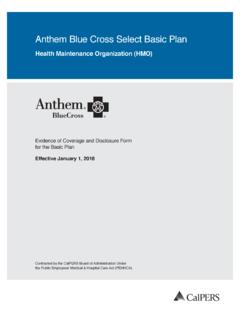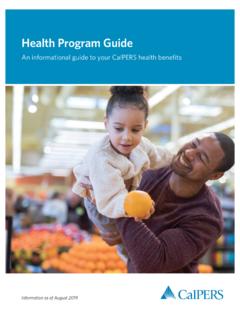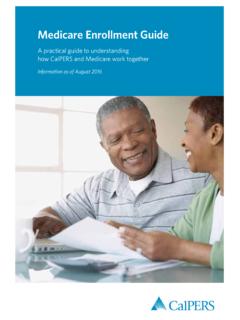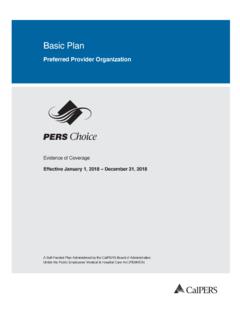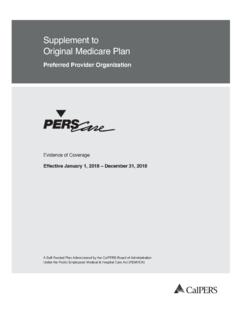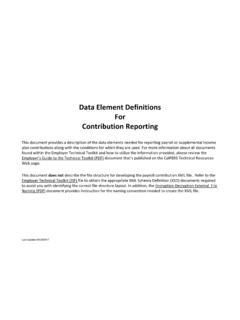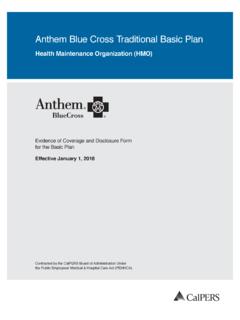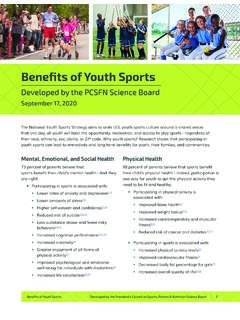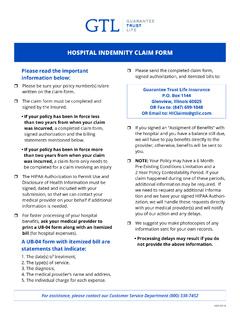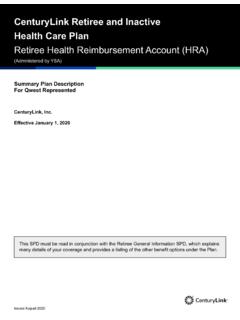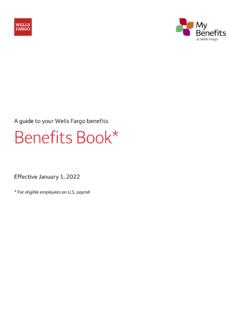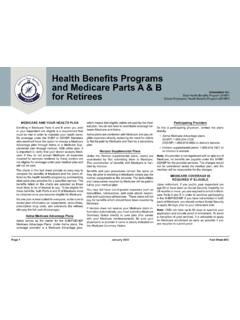Transcription of A Guide to CalPERS Community Property (PUB 38A)
1 A Guide to CalPERS Community PropertylearndecideconsultLearn the Facts About Community PropertyCommunity Property is Property owned jointly in marriage or registered domestic partnership and is subject to division upon dissolution of a marriage or registered domestic partnership, or a legal separation. In California, all types of retirement benefits are considered Community publication provides guidance to our members, nonmember spouses, and attorneys who may be assisting either party through the divorce statements in this publication are general and should not be considered a substitute for legal advice. By law, CalPERS cannot provide legal advice. This publication explains methods and requirements for dividing CalPERS benefits. For other savings plans, such as the Supplemental Income Plan, please contact the plan administrator for information on dividing these does not need to be notified if the member and nonmember spouse reach an agreement where the member keeps 100% of the CalPERS retirement pension and there is no outstanding Community Property claim on the member s account.
2 We recommend that the marital settlement agreement or judgment of dissolution state this. Otherwise, this could be considered an omitted asset and a claim against the member s CalPERS pension could still be finalization of divorce or termination of domestic partnership, the member will need to submit a copy of the Notice of Judgment of Dissolution or Termination of Domestic Partnership so we can update any existing relationship status on their CalPERS Plan ..2 The Community Property Process ..3 How to Request Member Account Information ..6 Health Benefits Information ..7 Benefit Forfeiture for Felony Convictions ..8 Information for Registered Domestic Partnerships ..8 Methods to Divide Community Property ..9 Instructions for Preparing the Model Orders ..18 Frequently Asked Questions ..31 How to Contact Us ..33 Visit Your Nearest CalPERS Regional Office ..34 Privacy Notice ..352 The CalPERS PlanCalPERS is a defined benefit plan funded by employee contributions, employer contributions, and earnings made on CalPERS investments.
3 Most employees contribute a percentage of their salary, which accrues interest under their individual CalPERS account . CalPERS members may choose to withdraw their contributions and interest if no longer working for a CalPERS -covered employer, or they may choose to receive a lifetime monthly retirement allowance once they become eligible .Retirement benefits vary depending on the employer s agreement with us . Review the California Public Employees Retirement Law (PERL), member publications, and our website at to learn more about the CalPERS plan and other member benefits . CalPERS is a governmental plan and is not subject to the Employee Retirement Income Security Act (ERISA) that governs Qualified Domestic Relations Orders (QDRO) . We can only accept the model orders described in this publication and will not accept an order that awards a nonmember spouse rights under ERISA .A nonmember spouse is the former spouse or registered domestic partner of a CalPERS member who is being or has been awarded a Community Property interest from the member s account.
4 A Qualified Domestic Relations Order (QDRO) is a legal order used in a dissolution of marriage or registered domestic partnership, or a legal separation, that divides a retirement plan to give the nonmember spouse his or her share of retirement benefits .3 The Community Property ProcessClaim NotificationCalPERS Benefits HeldClaim ResolutionCalPERS Benefits Released The Community Property process starts when we receive written notification of a claim, a summons (joinder), or a proposed or filed order awarding a nonmember spouse a portion of a member s benefits . A hold is placed on the member s account and benefits are held until the claim is resolved .A claim is written notification against a member s account that a legal separation, divorce, or termination of domestic partnership exists . Only a nonmember spouse or his or her attorney can submit a claim, and this can be done at any time . A summons (joinder) is a legal term referring to the documents filed with the court that join CalPERS as a party to the dissolution or legal separation.
5 The joinder allows us to provide information about a member s account to the nonmember spouse, and to their respective attorneys . If the divorce is filed outside of California, or out of the country, CalPERS does not need to be joined .Summons (joinder) forms may be obtained from the Superior Court clerk s office in the county in which the divorce or separation is filed, or you can download the forms from the California Courts website at . Summons (joinder) forms may be filed by the member or nonmember spouse and do not need to be filed by an attorney .A proposed order is a legal document that states the proposed division of Community Property and has not been filed with the court . A filed order is a legal document that has been filed with the court . Held BenefitsFor active and inactive members, we will not release any service or disability retirement benefits, health or dental benefits, refund of contributions, or death benefits until the claim is resolved.
6 An active member is a member of CalPERS who is currently working in a CalPERS - covered position .An inactive member is a member who is not currently working in a CalPERS -covered position, has service credit and/or contributions on account, and is not retired .A member may still apply for retirement pending resolution to an unresolved Community Property claim; however, no benefits can be released until the Community Property issue is resolved . Once benefits become payable, they will be released and paid retroactively to the member s retirement date . For retired members, we hold one-half of the retirement allowance until the claim is resolved, unless we receive written notification from the 4nonmember spouse or the nonmember spouse s attorney asking us to continue to pay the full allowance (Family Code section 755) . When one-half of the member s retirement allowance is held, the nonmember s Community Property interest is paid retroactively to the date we started holding half of the member s allowance.
7 If we pay the member s full retirement allowance, the nonmember s Community Property interest is paid prospectively and is effective as soon as administratively possible after CalPERS receives an acceptable filed court order .How to Resolve a ClaimThe death of the member or nonmember spouse does not automatically dismiss a claim . The Community Property interest must still be resolved .An account hold can be resolved by one of the following:Resolution MethodWhat You Need to KnowNotarized LetterA notarized letter from the nonmember spouse or his or her attorney requesting to withdraw the claim . Note: We cannot accept a notarized letter to withdraw the claim if a summons (joinder) was submitted to start the claim .Request for Dismissal of Summons (Joinder)A filed Request for Dismissal of Summons (Joinder), which asks the court to terminate or dismiss the summons (joinder) we have on file . A Request for Dismissal of Summons (Joinder) can usually be obtained at a courthouse or on the internet.
8 Qualified Domestic Relations Order (QDRO)An acceptable filed Qualified Domestic Relations Order (QDRO), which is a court order dividing the Community Property that has been filed with the court, reviewed, and approved by CalPERS . This can be a proposed court order or filed court order: Proposed Court Order We recommend submitting a proposed order for us to review . We will determine within 60 days of receipt if it meets the terms of the PERL and is acceptable as written . If it is acceptable, then it is ready to be filed with the court and resubmitted to us for final review . If it is unacceptable, we will provide written notification to all parties that amendments are required . If the parties require a CalPERS representative signature before filing the order with the court, we will only sign the order after both parties have signed . We are aware that only some courts require a CalPERS signature.
9 To determine if your court requires a signature from CalPERS , you would need to check with the court directly . Filed Court Order We will determine if a filed order meets the terms of the PERL and is acceptable as written within 60 days of receipt . If it is acceptable, we will notify all parties in writing and comply with the terms of the order based on the method of division . If it is unacceptable, we will provide written notification to all parties that amendments are required .Graphic continued on next Community Property Process (continued)5 Resolution MethodWhat You Need to KnowCertified Copy of a Court OrderA certified copy of a court order, such as a marital agreement, that specifically states the CalPERS retirement is the member s sole and separate Property . Community Property Release FormThe nonmember spouse can submit a Community Property Release form to release his or her Community Property interest.
10 This form can be used when a court order, such as a marital settlement agreement or judgment of dissolution, has awarded the nonmember spouse a Community Property interest and he or she wants to release all entitlement to those benefits . We will mail the Community Property Release form upon request from the nonmember spouse and only upon receipt of a court order showing the nonmember spouse was awarded a Community Property interest in the member s CalPERS retirement . This form cannot be used if the claim was made by a summons (joinder) . A filed Request for Dismissal of Summons (Joinder) is required .Releasing CalPERS BenefitsMembers who have submitted a retirement application will receive benefit payments within 60 days after we determine the filed court order is acceptable, the application received date, or their retirement date, whichever is later .Retired members will receive the adjusted benefit payment amount within 60 days after we determine the filed court order is acceptable.

